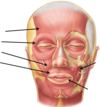Clinical Anatomy of Cranial Nerve Testing Flashcards
List the ‘12’ Cranial Nerves and their modalities
CN I olfactory nerves (special sensory)
CN II optic nerves (special sensory)
CN III oculomotor nerves (motor & parasympathetic)
CN IV trochlear nerves (motor)
CN V trigeminal nerves (CN V1 & V2: sensory only*; V3 is sensory & motor*)
CN VI abducent nerves (motor)
CN VII facial nerves (special sensory; motor & parasympathetic)
CN VIII vestibulocochlear nerves (special sensory)
CN IX glossopharyngeal nerves (special sensory; sensory; motor & parasympathetic)
CN X vagus nerves (sensory; motor; parasympathetic)
CN XI spinal accessory nerves (motor)
CN XII hypoglossal nerves (motor)
Which part of the CNS do each originate from?
Forebrain - I, II
Midbrain - III, IV
Pons - V
Pontomedullary junction - VI, VII, VIII
Medulla - IX, X, XII
Spinal cord - XII
Label from view superior to cranial fossae


Through which cranial fossa do each of the Cranial nerves leave the crainial cavity?
Anterior fossa - CN I
Middle fossa - CN II, III, IV
Posterior fossa - CN V - CN XI
Foramen magnum - CN XII
Describe the divisions of the trigemninal nerve
3 divisions
- Ophthalmic (CNV1) – sensory
- Maxillary (CNV2) – sensory
- Mandibular (CNV3) – sensory and motor
Describe and detail the course of the Trigeminal Nerve
CNS connection:
The only CN to attach to the pons (laterally, midway between midbrain & medulla)
Intracranial Course:
inferior to the edge of the tentorium cerebelli between the posterior and middle cranial fossae
Skull Base Foramen:
- CN V1 - superior orbital fissure
- CN V2 - foramen rotundum
- CN V3 - foramen ovale
Extra-cranial Course:
- Sensory axons from all 3 divisions course, from the superficial and deep structures of the face, posteriorly, towards their respective base of skull foraminae
- motor axons from CNV3 course from the foramen ovale towards the skeletal muscle they supply
Label the somatic sensory innervation to the head


CN V1 deep sensory territory?
- bones & soft tissues of the orbit (except the orbital floor & lower eyelid)
- the upper anterior nasal cavity
- all paranasal sinuses (except the antrum)
- the anterior & posterior cranial fossae
CN V2 deep sensory territory?
- the lower posterior nasal cavity
- the maxilla & maxillary sinus (antrum)
- the floor of the nasal cavity/palate
- the maxillary teeth & associated soft tissues (gingivae & mucosae)
CN V3 deep sensory territory?
- the middle cranial fossa
- the mandible
- the anterior 2/3rds of the tongue
- the floor of the mouth
- the buccal mucosa
- the mandibular teeth & associated soft tissues
Name and detail the muscles of masstication
Close Jaw
- Masseter
- Temporalis
- Medial Pterygoid
Open Jaw
-Lateral Pterygoid
Describe the origin and attachments to the muscles of masstication
Masseter - Angle of mandible - Aygomatic arch
Temproalis - coronoid process of mandible - lateral aspect of neurocranium
Medial Pterygoid - Medial mandible - Pterygoid plates fo the sphenoid bone
Lateral Pterygoid - Condyle of mandible and articular disc of TMJ - Pterygoid plates of the spenoid bone
List the key areas for testing the sensory afferent of the Trigmeninal Nerve
- Ophthalmic (CNV1):
- forehead, upper eyelid & tip of nose
- Maxillary (CNV2):
- mid-cheek, lower eyelid, upper lip & nostril of nose
- Mandibular (CNV3):
How would you clinically test the Sensory afferent of the trigemnial nerve?
- Ask the patient to close their eyes
- Gently brush the skin in each dermatome with a fine tip of cotton wool
- Ask the patient to tell you when they feel their skin being touched
- Compare the 2 sides
How would you clinically test the motor efferent of the trigeminal nerve?
- Palpate the strength of contraction of the masseter & temporalis by asking patient to clench their teeth
- Ask the patient to open their jaw against resistance











